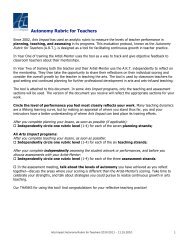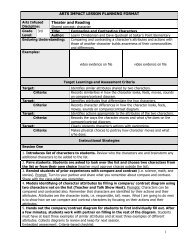ARTS IMPACT INSTITUTE LESSON PLAN - Core Program Year 2 ...
ARTS IMPACT INSTITUTE LESSON PLAN - Core Program Year 2 ...
ARTS IMPACT INSTITUTE LESSON PLAN - Core Program Year 2 ...
Create successful ePaper yourself
Turn your PDF publications into a flip-book with our unique Google optimized e-Paper software.
2. Introduces concept of visual dynamism. Facilitates class analysis of works of art, looking<br />
for ways artists create visually dynamic compositions (diagonal lines, contrasting colors and<br />
values, etc). Prompts: Where do your eyes go first in these compositions? What did the artists<br />
do to draw your eyes there? The ways that an artist makes an image exciting – like using<br />
diagonal lines to draw our eyes to an important person or event – is called visual dynamism.<br />
Student: Analyzes works of art for visual dynamism.<br />
Embedded Assessment: Criteria-based teacher checklist<br />
3. Introduces concept of visual unity. Facilitates class analysis of works of art, looking for<br />
ways artists create visual unity in compositions (repeating shapes, colors, textures, patterns,<br />
etc.). Prompts: Even though there are lots of things going on in these two images, the artists<br />
also made everything in the picture look like it belongs together. This is called visual unity.<br />
How did Jacob Lawrence and James McNeil Whistler make everything in their pictures look like<br />
they relate to each other or belong together? One way artists do this is by repeating patterns,<br />
shapes or colors in different parts of the same picture. When artists create a series of images to<br />
tell a story, they do the same thing to make all the images relate to each other.<br />
Student: Analyzes works of art for visual unity.<br />
Embedded Assessment: Criteria-based teacher checklist<br />
4. Reads a story aloud (or students select and read different stories separately). Guides<br />
students to summarize pivotal moments in the beginning, middle and end of the story with<br />
descriptive words for each point. Then guides students to do two different visually dynamic<br />
sketches of each of those moments (six sketches total). Prompts: I am going to read you a<br />
story. Your job is to summarize the pivotal moments in the story with a few descriptive words<br />
for the beginning, middle and end of it. Then I want you to do two different sketches for each<br />
of those points. Try to make your sketches as visually dynamic as you can (using diagonal<br />
lines and contrasting colors), but remember a sketch is just a quick working drawing. It’s not<br />
perfect, and it’s not the finished work of art.<br />
Student: Fills in graphic organizer with words describing pivotal moments in the beginning,<br />
middle and end of the story. Sketches images that correspond to those moments (two for each<br />
story segment). Selects most visually dynamic compositions (one for each story segment).<br />
Embedded Assessment: Self assessment; criteria-based teacher checklist<br />
5. Guides students in making series of three visually dynamic and visually unified<br />
collage compositions, expressing the beginning, middle and end of the story. Prompts: Using<br />
our sketches as a guide, we are going to make three collages, one for each part of the story.<br />
Your job is to make your collages both visually dynamic by using diagonal lines, and visually<br />
unified by repeating some shapes, patterns and/or colors in each picture. Eventually, we are<br />
going to add lines to our pictures by doing prints on top of our collages, so let the collages be<br />
simple and bold—simplify your shapes to create the story elements—character attributes and<br />
setting. Little details in the collages won’t show up when we add our prints on top.<br />
Student: Uses sketches to make three collages (one each for beginning, middle, and end of<br />
story). Collages are visually dynamic (uses diagonals) and visually unified (repeats some colors,<br />
patterns and/or shapes).<br />
Embedded Assessment: Peer assessment (trade with partner, check for visual dynamism and<br />
visual unity before going on to final printmaking step).<br />
6. Demonstrates monoprintmaking process, and guides students in making monoprints<br />
onto their collages. Facilitates full-class critique of finished images. Prompts: Both Jacob<br />
Lawrence and James NcNeil Whistler made prints as well as paintings. A print is a picture that<br />
Arts Impact <strong>Core</strong> 2 – Arts Infused Summer Institute – Visual Arts: Pivotal Images: Beginning, Middle, End

















